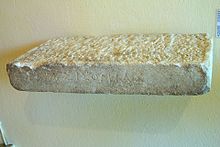Despotiko
| Despotiko (Δεσποτικό) | ||
|---|---|---|
| Waters | Mediterranean Sea | |
| Archipelago | Cyclades | |
| Geographical location | 36 ° 58 ′ N , 25 ° 0 ′ E | |
|
|
||
| length | 5.18 km | |
| width | 3 km | |
| surface | 7.754 km² | |
| Highest elevation | Chondro Vouno 189 m |
|
| Residents | uninhabited | |
Despotiko ( Greek Δεσποτικό [ ðɛspɔtiˈkɔ ] ( n. Sg. )) Is an uninhabited small Greek Cycladic island in the South Aegean region (Περιφέρεια Νότιου Αιγαίου). Administratively it belongs to the municipality of Andiparos .
geography
Despotiko is located southwest of Andiparos , only 1 km opposite the settlement of Agii Giorgis and close to the islands of Tsimintiri and Strongyli . The island has beautiful sandy beaches and can be reached by boat from Andiparos. The target is usually a sandy beach in the eastern part of the island.
history
Despotiko is uninhabited today. However, excavations have provided evidence of settlement since the Bronze Age . Until at least the Hellenistic period, Despotiko and the island of Tsimintiri were connected to Andiparos by a flat isthmus. The island is recorded under its ancient name Presepinthos in various ancient maps and sea maps, also mentioned in the Geographika by Strabo and the Naturalis historia by Pliny . In 1675 the island was looted by pirates, the surviving inhabitants then left the island.
Archaeological finds
In 1841, Karl Gustav Fiedler mentioned mighty pieces of marble near the sea in the northeast of the island and assumed the remains of an ancient sanctuary. Conrad Bursian confirmed these observations in 1862. Even James Theodore Bent reported in 1885 by foundations of a temple near the sea in the north-east of the island at the point Mandra (Μάντρα) as well as prehistoric graves on the island.
In Livadi discovered Christos Tsountas 1897 three spatially separated groups of graves bronze age Cyclades culture with about 18 partly multistory Steinkiste graves, opened at Zoumbaria further 14 graves, and identified the remains of the prehistoric settlement Chiromilos with mounting wall. In 1959, Nikos Zapheiropoulos opened another 20 at Zoumbaria . In the immediate vicinity of the graves he discovered fragments and remains of a wall surrounding the associated settlement. The grave architecture and inventory date from early Cycladic I to the end of early Cycladic II. The graves contained more than 40 violin and 3 pebble idols, marble vessels and obsidian blades.
The first archaeological investigations on the Mandra site were carried out in 1959 under the direction of Nikos Zapheiropoulos. In 1997 excavations began. Archaeologist Giannos Kouragios and his team have brought important archaeological finds to light. Three archaic kouros parts were unearthed in a well-preserved condition during the excavations on Despotiko. There are two bodies and a head from the year 560 BC. The Kouroi were found in a sanctuary dedicated to Apollo . The excavations are proceeding slowly and carefully as there are still many hidden treasures suspected on the island.
Despotiko has been declared an archaeological site. The Archaeological Commission proposed that the whole island be declared an “archaeological park”, an open-air museum.
natural reserve
Due to the typical plant occurrence of the Cyclades with holm oaks , Phoenician juniper and gorse, Despotiko and the neighboring island Strongyli were designated as Natura 2000 area GR 4220017 Islands Despotiko and Strongylo (Νησί Δεσποτικό και Στρογγυλαό κασι Θα.
Web links
Individual evidence
- ↑ Ελληνική Στατιστική Αρχή [ΕΛΣΤΑΤ]: Στατιστική Επετηρίδα της Ελλάδος ( Statistical Yearbook of Greece ) 2009 & 2010. Piraeus 2011, p. 47.
- ↑ Τα βουνά των Κυκλάδων
- ↑ Erich Draganits: The archaic sanctuary on Despotiko Island (Cyclades): Geological outline and lithological characterization of the building stones, with their possible provenance. In: Austrian Journal of Earth Sciences. Number 102, Vienna 2009, pp. 91-102. PDF online
- ↑ Yannos Kourayos, Kornelia Daifa, Aenne Ohnesorg, Katarina Papa Janni: The Sanctuary of Despotiko in the Cyclades. Excavations 2001–2012. Archäologischer Anzeiger, 2012,2 (2013), p. 93 Online
- ^ Karl Gustav Fiedler: Journey through all parts of the Kingdom of Greece. Leipzig 1841, p. 201. Online
- ^ Conrad Bursian: Geography of Greece. Second volume. Peloponnese and islands. BG Teubner, Leipzig 1862, p. 482. Online
- ↑ James Theodore Bent: The Cyclades or Life among the insular Greeks. London 1885, p. 413 online
- ↑ Christos Tsountas: Cycladica. In: I En Athines Archeologiki Eteria (ed.): Ephimeris archaiologiki , Athens 1898, pp. 162-165. (Digitized: online )
- ↑ Tsountas: Cycladica. 1898, p. 176. Online .
- ↑ Nikos Zapheiropoulos: Αρχαιότητες και μνημεία Κυκλάδων. Δεσποτικόν. ADelt 16, 1960, pp. 246-247. (Greek)
- ↑ Jörg Rambach: Schematic marble figurines from secure Early Cycladic I grave contexts on the islands of Ano Kouphonisi, Antiparos, Dhespotiko, Naxos, Paros and Siphnos. In: Marisa Marthari, Colin Renfrew, Michael Boyd (Eds.): Early Cycladic Sculpture in Context . Oxbow Books, 2017, ISBN 978-1-78570-195-5 , pp. 72-75, 80.
- ↑ Nikos Zapheiropoulos: Αρχαιότητες και μνημεία Κυκλάδων. Δεσποτικόν. ADelt 16, 1960, p. 247. (Greek)
- ^ The sanctuary of Apollon on Despotiko near Antiparos (Cyclades) , Technical University of Munich
- ↑ Κήρυξη ως αρχαιολογικού χώρου των νησίδων Δεσποτικό, Τσιμιντήρι και Στρογγυλό Ν. Κυκλάδων. (ΦΕΚ 944 / Β / 31-7-2000) (Greek)
- ↑ Natura 2000 area GR4220017 (English)

